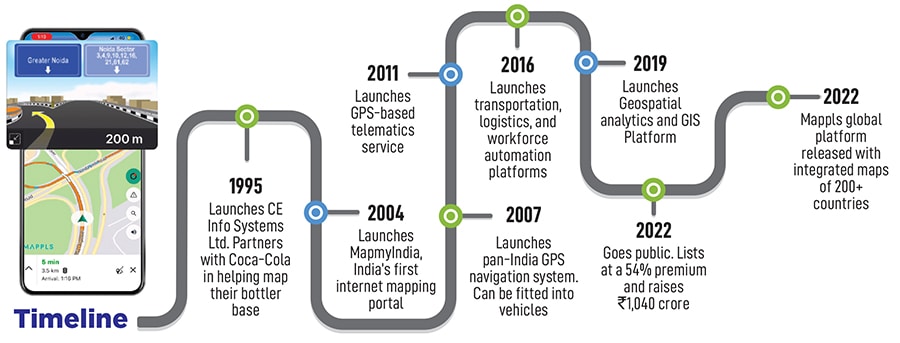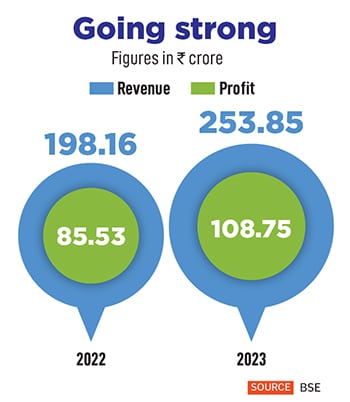“I was the only woman in my class," says Verma who studied chemical engineering. It’s something akin to a story that’s often associated with Sudha Murthy, the wife of Infosys founder Narayana Murthy, who was also the only engineering student at her college. “I wish there were more women. I think I could have had more fun."
Soon enough, her husband, Rakesh Verma cuts in. “Still, she couldn’t find a guy to get married," Verma, sporting classic hexagonal specs, says. The duo was married in Rashmi’s third year of college, and in many ways, if it wasn’t for the marriage, the ₹10,500 crore CE Info Systems, wouldn’t have come about. CE Info Systems owns MapmyIndia, an early mover in India’s digital mapping ecosystem, and competes with the likes of Google Maps.
MapmyIndia, founded by Rashmi and Rakesh, provides users with door-to-door directions that include traffic updates, speed-limit alerts, and pothole warnings. It also offers a suite of services to corporates including geospatial planning, fleet tracking and field force management. The company has so far mapped nearly 18 million locations in the country in addition to over 6 million km of road and captured nearly 15 million addresses in the country.
A new consumer app, Mappls, like Apple Maps and Google Maps, already has over 10 million downloads, all of which came organically. Additionally, MapmyIndia also licenses its data and software to clients spanning automotive, banking, and ecommerce, and currently services over 850 clients.
Last fiscal, CE Info Systems posted total revenues of ₹253 crore, with net profits of ₹108.75 crore. A significant chunk of the company’s revenues come from providing mapping services to other businesses such as Apple, Mahindra, BMW, and Amazon, among others.
“The fundamental reason why we were able to succeed was that Rakesh’s areas of capabilities, and my area of capability were mutually exclusive," the 67-year-old says. “So, there was no conflict. His area of expertise was the business side of things, and mine was the technical and technology side of things."
In November last year, MapmyIndia announced a plan to raise funds of up to ₹500 crore via a qualified institutional placement (QIP) route, which it reckons will help fund its long-term growth strategy including growth in its international business, drone as a service business and in ramping up its navigation services.
![]()
“I think one of my key contributions has been to help women come up in the organisation as well as being able to nurture the talent pool," says Verma, who serves as the CTO. “One of the things we also established in the beginning, and which is the bedrock of our foundation, is the organisation culture. We talked about respect for individuals, the importance of customers, integrity, and hard work. We made sure excellence was always rewarded. That is why we have been able to build a large pool of dedicated professionals."
Now, with the Indian government announcing a new geospatial policy that seeks to promote homegrown players, and restricting foreign players in the country, CE Info Systems has also seen an 87 percent rally in its share price through the past year. In addition, with the Competition Commission of India asking Google to unbundle Google Maps from its offerings on Android phones, MapmyIndia also believes that it has tremendous opportunities for its Mapples app in its B2C business.
Building it together
Verma grew up in Barelli in UP, where her father worked in the Indian Railways. “I was good at studies, and I was encouraged to take on different challenges, and something that my father encouraged me to go for was engineering," Verma says.
In her third year of college, she married Rakesh, a graduate of the Birla Institute of Technology and Science, and within a year of her graduation, the couple moved to the US, where Verma began pursuing a master’s degree in computer science and operations research at the Eastern Washington University. Rakesh, meanwhile, completed his MBA from the same university.
“I got a flavour of both computer science and operations research, which I feel is a very good thing," Verma says. “Operations research gave me the foundation in data analytics at that time." While Verma went on to work with IBM, her husband began working with General Motors. Over the next 12 years, Verma says the couple lived the quintessential American dream, but had always wanted to move back to India.
![]() However, moving back to India had its own challenges, especially since India was in the midst of opening up the economy after many decades of a protectionist regime. In 1993, the duo travelled to Atlanta in the US to attend Comdex, the largest software industry exhibition in the US, when the duo came across the idea of digital maps.
However, moving back to India had its own challenges, especially since India was in the midst of opening up the economy after many decades of a protectionist regime. In 1993, the duo travelled to Atlanta in the US to attend Comdex, the largest software industry exhibition in the US, when the duo came across the idea of digital maps.
“Somehow, we felt that the usefulness of a digital map was not in finding just a place," Verma says. “With our orientation towards offering solutions, and solving pain points in India, we could perceive and visualise at that time that the solutions built on top of digital map is the real power of digital map. People know us as mapmakers, but that was not the end goal. Map was the medium by which we wanted to solve so many different pain points for the country."
Soon enough, the Vermas flew to Albany in New York state to strike a deal with Mapinfo, the company that showcased the software, to create and digitise maps. The idea was to become their India distributor. It was around the same time, on the back of the new economic policy, that Coca-Cola was re-entering the Indian market after leaving the country in 1978.
By 1995, CE Info Systems was formed by the Vermas from their personal savings, and Coke, which had acquired Thums Up, turned to the Vermas to map out its complex network of bottlers, each holding their own territory, using written records. That was done through field surveys, collection, and compilation of major landmarks, roads, rivers, city, district, and locality information. CE Info Systems would go on to partner with Coca-Cola for more than a decade.
“Rakesh would go and discuss with the companies how mapping would bring operational efficiencies, improve sales, and market penetration, where they would get excited," Verma says. “My role was to keep listening to the business side and focus on building those solutions. When he brought the order, we had to scramble to put together the entire thing."
That also meant a heavy focus on the product in addition to providing the requisite training to the employees. The Vermas banked on a top-down and bottom-up approach, which they say has been the foundation on which the company has been built, allowing it to take on any competition in the segment.
By the turn of the century, as internet began finding its way into homes, the Vermas, having already built up a strong digital map database, were ready to unveil India’s first internet mapping digital portal, MapmyIndia. The name was closely on the heels of MakeMyTrip, another new-age travel portal. By then, satellite imagery had become readily available in India. “Post that, we started working in the area of navigation, and even launched our own portable navigation device in 2017," Verma says.
![]()
The growth spurt
Over the next decade, the company consistently began innovating on its platform, especially on the back of the smartphone boom in the country, offering everything from telematics to APIs and SDKs that would help ecommerce companies, fleet management operators, and food delivery apps with map and navigation solutions.
All that has meant that the company has been able to build up a steady stream of B2B customers, even as it now turns its focus to the B2C segment. Already, CE Info Systems says that the company has between 80-90 percent volume market share in new vehicles for maps and technology solutions among automobile OEMs.
The company also launched a geospatial analytics product, mGIS, which helps in processing, publishing, visualising, and analysing geospatial data to provide location-based services for corporates. These offerings are used by customers for optimising supply chains and logistics. “It is a one-of-its-kind software and organisations are really lapping it up because they can use their data on top of Mapmyindia’s data to analyse their processes and bring operational efficiency," Verma says.
![]()
Today, CE Info Systems’ offerings include a digital map and geospatial data, location-based IoT and fleet management, field workforce automation, automotive and location suite, and a digital transformation suite among others for corporates. Over the next few years, with India’s smartphone revolution underway, MapmyIndia is also turning its attention to AI/ML and the Metaverse, among others, as it prepares for its next leg of growth.
“Our current products also need to be refreshed with newer technologies," Verma says. “We are also building some more empowering platforms using AI, in addition to adding to our international maps." The company has already launched its Mapples product in 15 countries.
So how does she look back at the past 30 years? “I think one of my key contributions comes in the people side," Verma says. “Throughout my 30 years, I have onboarded people and trained them because GIS technologists or map data creators were not around. So, building this technology and talent has been my forte."


 However, moving back to India had its own challenges, especially since India was in the midst of opening up the economy after many decades of a protectionist regime. In 1993, the duo travelled to Atlanta in the US to attend Comdex, the largest software industry exhibition in the US, when the duo came across the idea of digital maps.
However, moving back to India had its own challenges, especially since India was in the midst of opening up the economy after many decades of a protectionist regime. In 1993, the duo travelled to Atlanta in the US to attend Comdex, the largest software industry exhibition in the US, when the duo came across the idea of digital maps.
